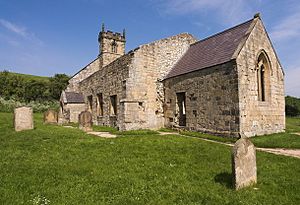Wharram Percy facts for kids
Quick facts for kids Wharram Percy |
|
|---|---|
 Ruin of St Martin's parish church |
|
| OS grid reference | SE 857 643 |
| Civil parish |
|
| Unitary authority |
|
| Ceremonial county | |
| Region | |
| Country | England |
| Sovereign state | United Kingdom |
| EU Parliament | Yorkshire and the Humber |
Wharram Percy is a fascinating place in North Yorkshire, England. It's known as a "deserted medieval village," which means it was once a busy village during the Middle Ages but is now empty. You can find it on the western edge of the chalk Wolds, a beautiful area with rolling hills. It's about 1 mile south of a village called Wharram-le-Street and is easy to find from the B1248 road.
For many years, people have known about the old village's earthworks, which are bumps and hollows in the ground that show where buildings used to be. These outlines of old houses were even drawn on maps back in 1854! From the 1950s to the 1990s, teams of experts like archaeologists and historians studied the site every summer. Today, Historic England looks after this special place.
A Look Back in Time: History
People lived in the area around Wharram Percy even before the Middle Ages. However, the village was most active between the 10th and 12th centuries. In 1086, a very old record called the Domesday Book mentioned it as 'Warran' or 'Warron'. The name 'Percy' was added later because a powerful family called the Percy family owned the land during the Middle Ages.
You might think the terrible Black Death plague in the 1300s caused the village to become empty, but it probably wasn't the main reason for Wharram Percy. While many people died across the country, encouraging some to move to bigger towns, something else led to this village's end.
Around the 1400s, the Percy family traded their land here with another family, the Hyltons. During the 15th century, it became more profitable for landowners to raise sheep than to grow crops like wheat. Over the next hundred years, the Hylton family started using more and more land for sheep. This meant they needed fewer farm workers. In the early 1500s, the very last people living in Wharram Percy were asked to leave, and their homes were taken down to make even more space for sheep to graze.
Exploring the Site Today
Today, Wharram Percy is looked after by Historic England. While only the ruined church can be easily seen above the ground, you can still spot the layout of the old village in the fields around it. Look closely, and you might see the outlines of old houses and streets!
Archaeologists have been studying this site since the 1950s. In 2002, Historic England did a big study of the area. In 2004, scientists studied human bones found in the churchyard. These bones told them a lot about what life was like for people in the medieval village, including what they ate, how healthy they were, and common diseases like tuberculosis.
If you enjoy walking, the Yorkshire Wolds Way National Trail goes right through the site. Another long-distance path, the Centenary Way, passes just to the east of the village.
St Martin's Church
The church at Wharram Percy, called St Martin's Church, changed a lot over time. It was built and rebuilt six times between the early 12th century and the early 17th century. The church tower fell down in 1959. When archaeologists dug inside the church, they found the remains of an even older stone church from the mid-11th century. They also found traces of a timber (wooden) building from the late 10th century, showing how old the site truly is!


